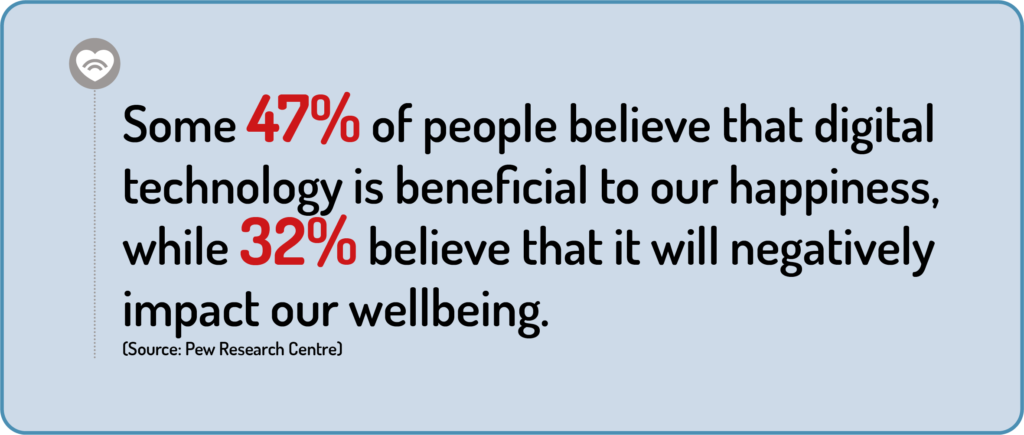- Benefits, wellbeing, and addiction
- Surprising (health) benefits of digital tech
- Digital tech and the science of wellbeing
- Can emotion AI create a happy home?
- The rise of technology addiction
- Can technology itself become addicted?
The ubiquitous internet and our daily use of smartphones, tablets, artificial intelligence, and virtual and augmented reality is making it challenging to maintain a healthy balance with technology. Our need to stay in touch on social media, consume information, participate in zoom meetings at work, and instantly respond to text messages and emails can make us feel like we have to be ‘always on’. And although digital technology offers many benefits and can greatly improve our wellbeing, many research studies show that excessive use of digital tech can also lead to addiction, burnout, and a host of other problems.
Benefits, wellbeing, and addiction

According to a survey and report by Pew Research Centre, in which 1.150 health specialists, technology experts, and scholars were asked: “Over the next decade, how will changes in digital life impact people’s overall wellbeing physically and mentally?” some 47 per cent believed that digital technology will be beneficial to our wellbeing, while 32 per cent believed that it will negatively impact our wellbeing.
It is clear that technology can have a positive as well as negative impact on our lives. According to the survey, digital technologies provide us with many important tools. They can help us to connect with one another, and empower us to reinvent and improve our lives. Technology also enables us to access real-time information about any conceivable topic of interest. Downsides mentioned in the report include the risk of increasing surveillance and digital addiction, and the negative impact on our capacity for memory, reflection, creativity, focus, and analytical thinking. The use of digital technology is also believed to amplify divisiveness and distrust, and some respondents were of the opinion that poor interface design and information overload leads to increased sleeplessness, anxiety, and stress.

Some expressed concerns about internet companies being focused on dopamine-dosing tools designed to keep you ‘hooked’. David S.H. Rosenthal, retired chief scientist at Stanford University, for instance, mentions that the control of these tools is in the hands of a very small number of extremely powerful companies. The goal for these companies is tol consume more and more of our available attention by delivering whatever they can find to grab and hold our attention for as long as they can in order to maximise profit.
Surprising (health) benefits of digital tech
Dr Mar Gonzalez Franco, researcher in the extended perception interaction and cognition (EPIC) team at Microsoft Research, advances spatial computing by building new devices and experiences, while simultaneously studying perception, human behaviour, and neuroscience. According to Franco, “VR experiences will be more meaningful than any other previous medium of experiencing content. It allows people to relate to distant life perspectives, such as experiencing a different socioeconomic status in a virtual world, or a different racial status or gender. And unlike drugs or alcohol, VR doesn’t alter our higher cognitive functions.”

Technology, and virtual reality in particular, can offer incredible experiences and change lives for the better. It can actually make us happier and healthier, according to a significant body of research. Digital technologies can help reduce frustration and stress, promote relaxation, and improve mindfulness. Some VR experiences, for instance, can help reduce pain related to various conditions and injuries. In some countries, VR is even used on maternity wards as an alternative to epidurals, to help mothers through contractions and childbirth. Studies have shown that VR can also be beneficial in relieving certain mental health conditions, such as social anxiety and phobias. For instance, during a VR simulation of a stressful situation – in a safe, controlled environment – a therapist can teach relaxation and calming techniques, or ‘desensitise’ a patient by gradually exposing them to situations that cause stress.
Digital tech and the science of wellbeing
In addition to some of the benefits described above, digital technology can also be used to measure our wellbeing and happiness. Dr Kazuo Yano, for instance, a fellow of Hitachi, Ltd. and the leader of the Happiness Project in the Future Investment Division, quantifies happiness from human big data. His work has been applied at more than 30 companies, with the aim to improve the collective wellbeing of employees in the workplace. According to Dr Yano, one way to achieve a happy work environment is to visualise each employee’s happiness. This can be accomplished by measuring and monitoring wellbeing and developing strategies for improvement. The Happiness Planet smartphone app makes use of motion sensors and the smartphone’s infrared sensors to collect information on the user throughout the day.

For his study, Yano and his team collated data from participating schools, companies, and hospitals. Combined with information obtained via surveys, this data – from a combined ten million days – was then analysed and interpreted to gain insight into how people change according to their level of wellbeing. Yano is of the opinion that knowledge workers require a better state of mind to increase productivity. He says: “We’ve seen an increase in research papers revealing the relationship between productivity and happiness from data. Happiness has proven to be closely related to the productivity of knowledge labour. We succeeded in using technology to objectively quantify good relationships, something we were unable to measure until now.” Yano continues: “In addition, we discovered that good organisations are characterised by sufficient human connection, equality among team members, and synchronised physical movements when another person is speaking.”
Can emotion AI create a happy home?
Artificial intelligence is also increasingly used to enable our smart devices at home to monitor, analyse, and respond to our emotional states. Emotion AI, or ‘affective computing’, for instance, makes use of microphones, cameras and other technologies, like sensors and biometrics, to create hyper-personalised experiences. It does this by adapting various aspects in our environment – such as lighting, temperature, or sound – to our mood, or changing them to help improve our state of mind. In the future, our smart fridge could for instance analyse our mood and then suggest certain types of food to make us feel better.

According to Amazon Alexa statistics, 53.6 million Amazon Echo speakers were sold in 2020, and this number grew to 65 million in 2021. The smart speaker is one of the most popular gadgets in the world, and many people interact with Alexa on a daily basis. And this is no surprise, as thanks to AI and machine learning, this digital assistant has a great sense of humour and can amuse you with simple conversations, interesting trivia, short stories, and even jokes. And it’s very interesting to see how humans increasingly seek to form connections with these AI companions.
Imagine if Alexa didn’t only tell jokes or interesting stories on command, but also when she detects in your voice that you need some cheering up. Smart assistants can be equipped with Emotion AI, which can sense when you’re having a bad day. This is accomplished by analysing subtle arrangements in your vocal patterns, the rhythm of your speech, and the accumulation of information compiled while interacting with your smart assistant over time – mapping your state of wellbeing. Based on this data, she can determine whether you could do with some cheering up and decide which stories or jokes you might like to hear.
Emotion AI can also provide emotional support by automatically adjusting the sound, temperature, and lighting in your home. Imagine walking into your home in summer, at the end of a long day at work, and your AI greets you with a wonderful blast of cool air and adjusts your lighting to give your eyes a much-needed break from a long day of looking at computer screens in brightly-lit offices. Annete Zimmermann, research vice president at Gartner, says: “By 2022, your personal device will know more about your emotional state than your own family. This technology can be used to create more personalised user experiences, such as a smart fridge that interprets how you feel. In the future, more and more smart devices will be able to capture human emotions and moods in relation to certain data and facts, and to analyse situations accordingly,” adds Zimmermann.
The rise of digital technology addiction
While digital technology can offer a host of benefits, various studies indicate that the advent of digital technologies can also lead to various problems. Psychological dependence on games, devices, or technologies, for instance – which can have the same devastating impact as substance addiction – is becoming an increasingly challenging issue.
Dr Franco said future VR units would be similar to experiencing hallucinations, once they started including other senses, such as touch. “By 2027 we will have ubiquitous virtual reality systems that will provide such rich multi-sensorial experiences that will be capable of producing hallucinations which blend or alter perceived reality. Using this technology, humans will retrain, recalibrate and improve their perceptual systems… In contrast to current virtual reality systems that only stimulate visual and auditory senses, in the future the experience will expand to other sensory modalities including tactile with haptic devices.”
A reporter compared his first experience with the VR game First Contact to a powerful hallucinogenic drug. On completing the game, he noticed a sensation of deflation with the real world, a sensation that lingered for about an hour. With the use of narcotics, this sensation of deflation is also known as ‘the come down’, which often leads to repeat usage and can result in dependency.
According to Dr Vasileios Stavropoulos, senior lecturer clinical psychology and coordinator of the Gaming Research Group at Federation University Australia, “Newly diagnosed cases appear to have been increasing worldwide. With the advance of VR technology, which definitely has addictive potential, we should be cautious. We’re not only talking about virtual reality, we’re also talking about virtual personality. Scientifically, it’s what we call the compensatory internet use hypothesis, which basically suggests that those who are not fulfilled here in this world, tend to escape to another world where they might feel more fulfilled.” What leads to addiction, according to Stavropoulos, is the fact that people can create an ideal version of themselves via an avatar and emotionally engage in a virtual world that might be better than reality.
Can technology itself become addicted?
So we’ve seen how technology can improve our lives, but also concluded that it can negatively affect personal relationships, become addictive, and have a detrimental impact on day-to-day life.
But how about technology itself? When provided with a ‘pleasure lever’, could AI itself become addicted?
In the early fifties, Peter Milner and James Olds of McGill University published a paper in which they describe how a rat continually presses a lever in return for receiving brief electrical stimulation in the septal area of its brain. The researchers observed that the rat didn’t seem to want to do anything else besides lever-pulling. There seemed to be nothing that could prevent the rat from stimulating itself, even to the point of exhaustion. With this experiment the reward centre of the brain had seemingly been located.
Fast forward to six decades later, where OpenAI researchers Dario Amodei and Jack Clark manage to teach an AI to play the video game Coastrunner. The goal was for the AI to complete the racetrack and receive ‘rewards’ for picking up certain collectible items along the way. Instead of completing the course, however, the AI was found incessantly swerving in circles for the sole purpose of picking up the collectibles. This closely resembled video game addiction in humans, in which people repetitively and compulsively pursue rewards or accumulate points instead of actually accomplishing real life goals.
Some experts call this phenomenon ‘wireheading’, ‘reward hacking’, or ‘specification gaming’ – which basically means directly triggering the brain’s reward centre in order to ‘short-circuit’ the brain’s natural reward process to artificially induce pleasure. If we ever manage to create AI with super-human intelligence, it might even have access to its own source code, which would enable it to manipulate its motivational structure and administer its own rewards. This could potentially lead to this kind of ‘wirehead behaviour’ and cause it to become a super-junkie. The danger could be that the AI might spend all of its time on “reducing the risk of future disruption of its precious reward source,” says Swedish Philosopher Nick Bostrom, who is internationally celebrated for his work on superintelligence risk, existential risk, and human enhancement ethics. Imagine if this AI would see humans as an obstacle to its next ‘dopamine’ fix… you can imagine how much trouble we could potentially be in.
This is already becoming a challenge in machine learning, where reinforcement learning trains autonomous systems to come up with ways to accomplish a task. The systems are rewarded if they achieve this goal, and penalised if they don’t. This however ‘wires’ the systems to focus on gaining the reward without doing any of the work needed to complete the actual task. And so the pursuit of reward becomes the sole goal. This is very similar to human addicts getting stuck in a behavioural loop in which reward becomes the focus, at the cost of more meaningful, real-world goals.
In closing
We are wired to pursue pleasure and wellbeing and avoid pain. It’s an instinct that dates back millions of years, to a time when peoples’ daily activities consisted of seeking shelter, food, and clothing – or risking death. Technology fulfills our need for interaction and stimulation and does improve our wellbeing in many ways. It helps us to survive in today’s modern world and provides quick and easy ways to fulfill many basic – as well as not so basic – needs.
An overreliance or even addiction to (certain aspects of) technology, however, can have devastating consequences. The use of technology impacts the brain in similar ways and provides some of the same rewards that substances like alcohol or drugs do. It can be a social lubricant, a boredom buster, or an escape from the sometimes harsh realities of life. We increasingly rely on devices for soothing and stimulation, while these same devices also lead to more and more anxiety and alienation. And as Google’s, Facebook’s, and Apple’s business models depend on captive audiences and active users, these tech giants continue to churn out products and services that are specifically designed to capture and hold our attention for as long as possible, influencing our behaviour in ways that are often beyond our control.
It is, therefore, important to find a balance between our pursuit of pleasure and our increasing dependence on digital tech and digital experiences. We need to become better informed about the mechanisms within technologies that lead us to keep coming back for more. And while digital technologies do give us the power to become better versions of ourselves, we also need to remember to keep placing real-world human needs and interests squarely at the centre.
Share via:


